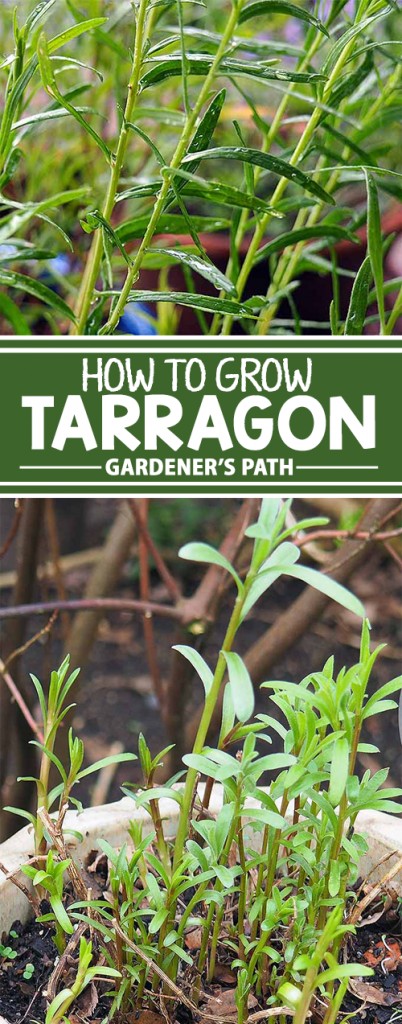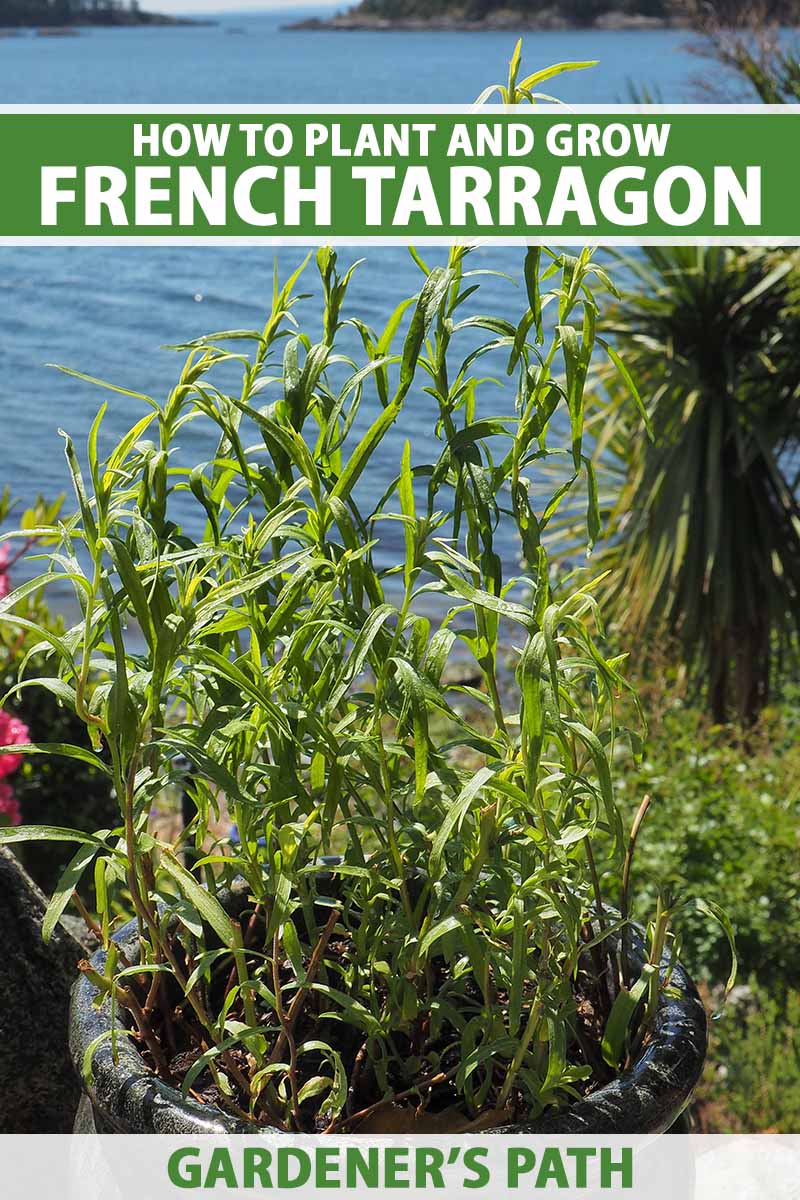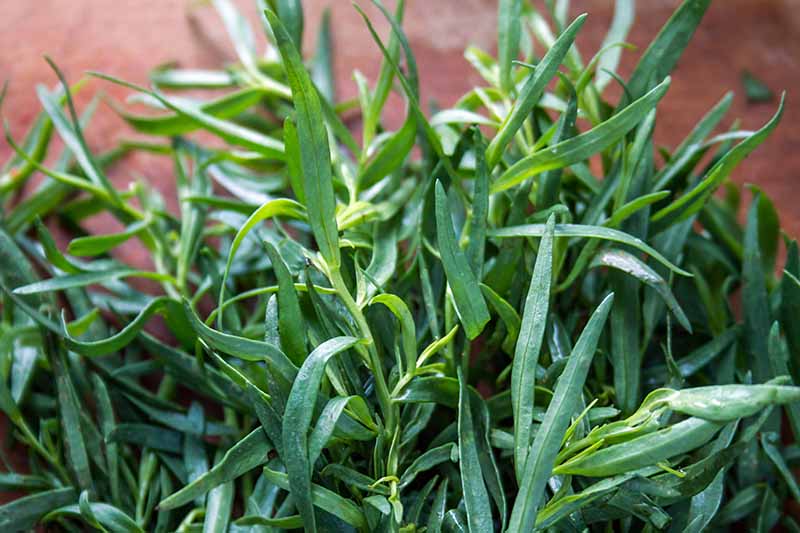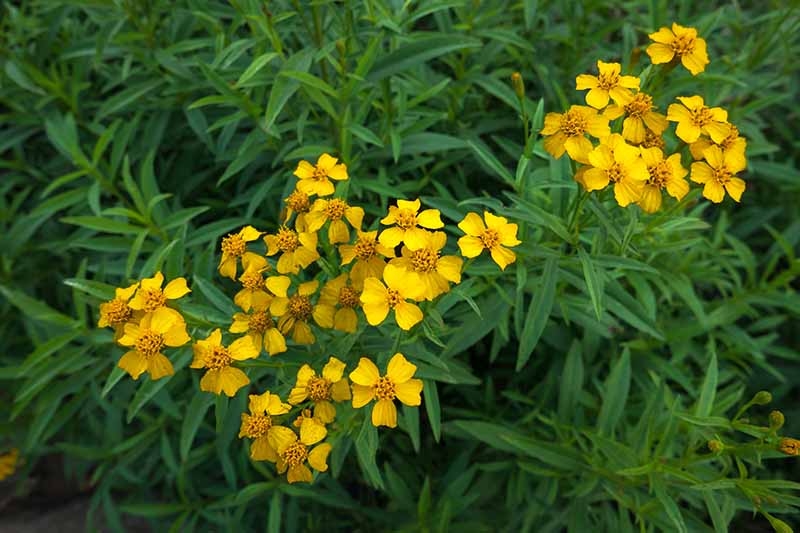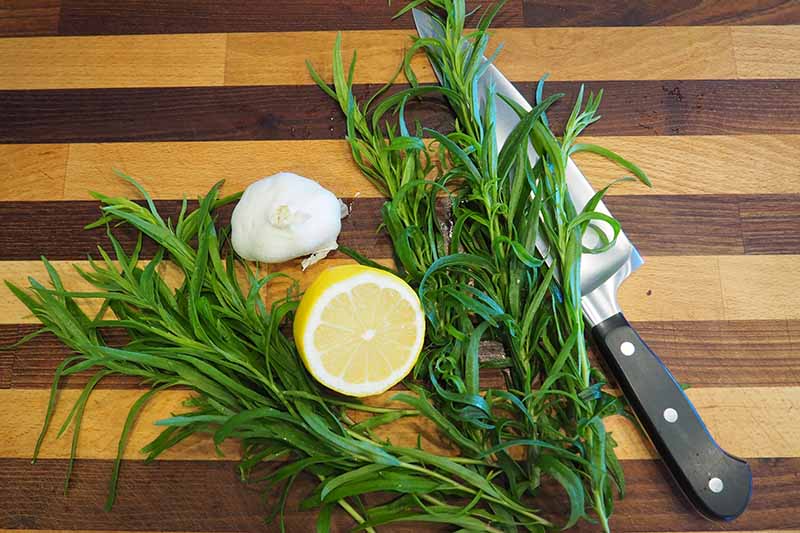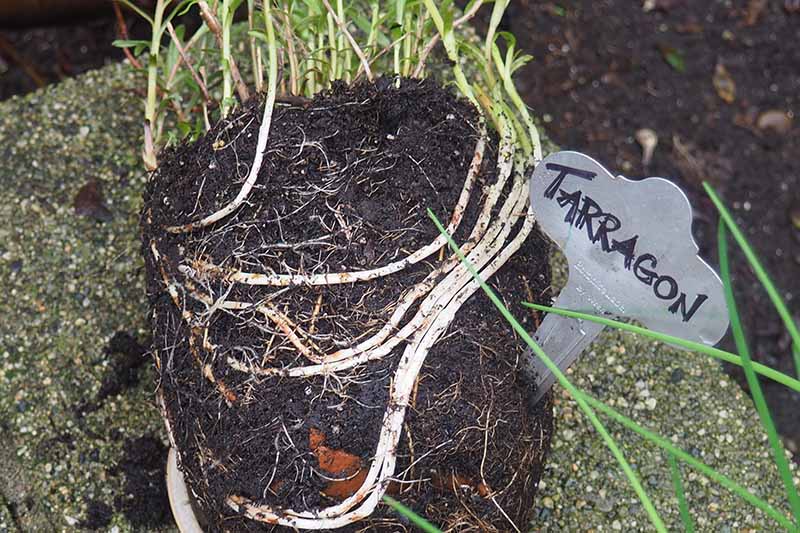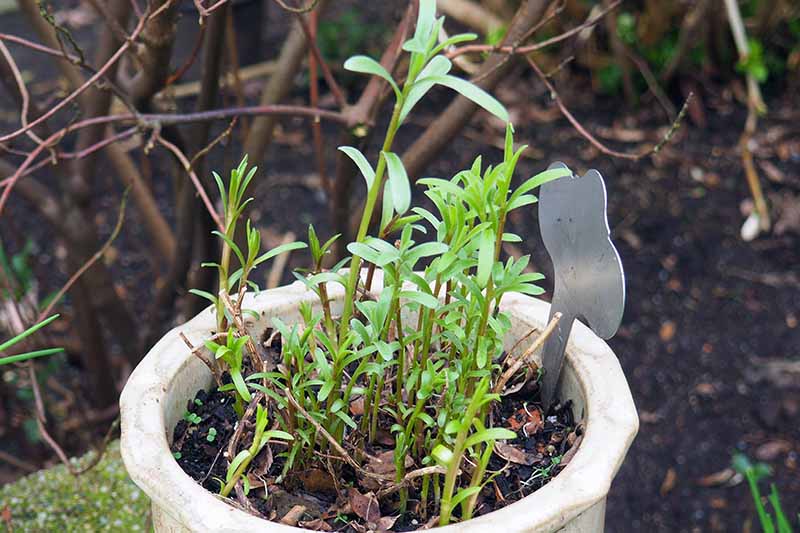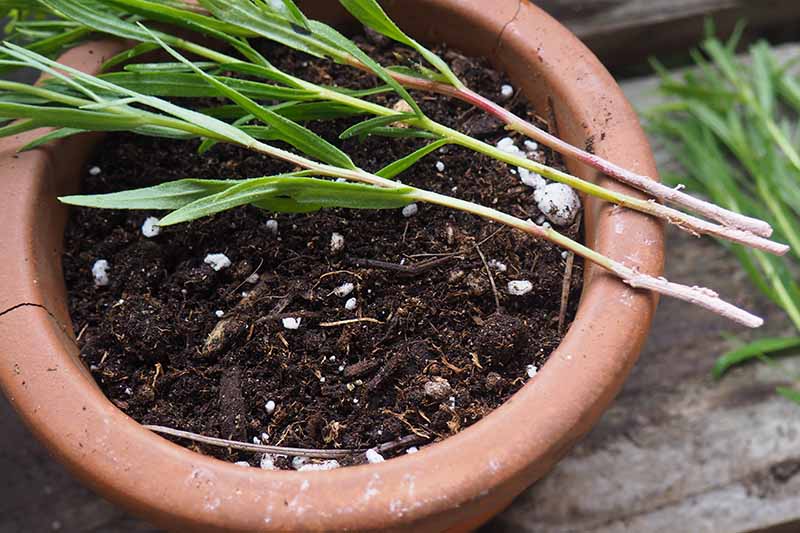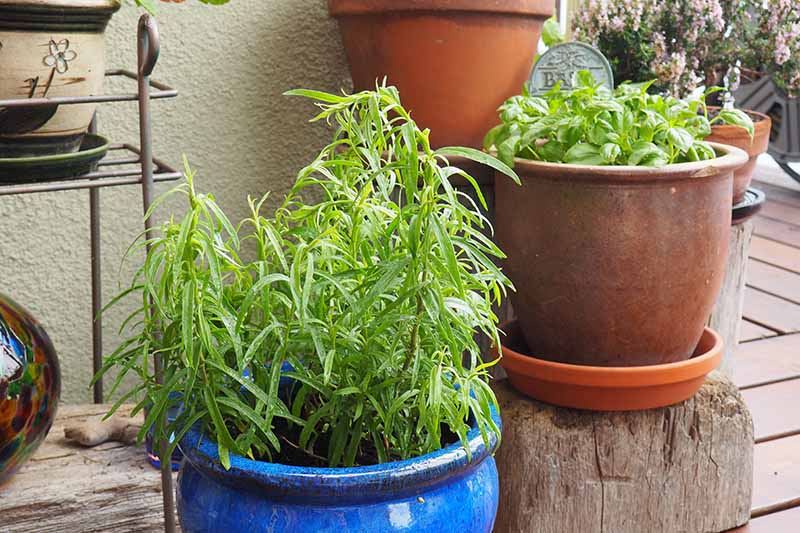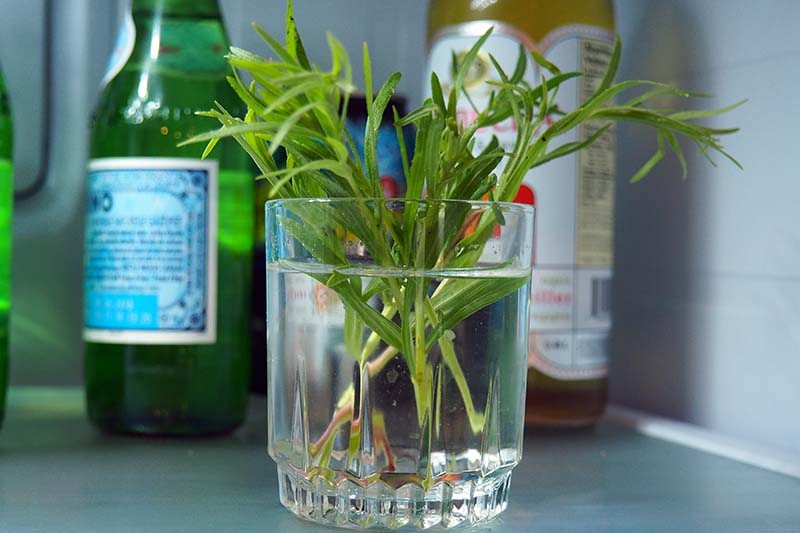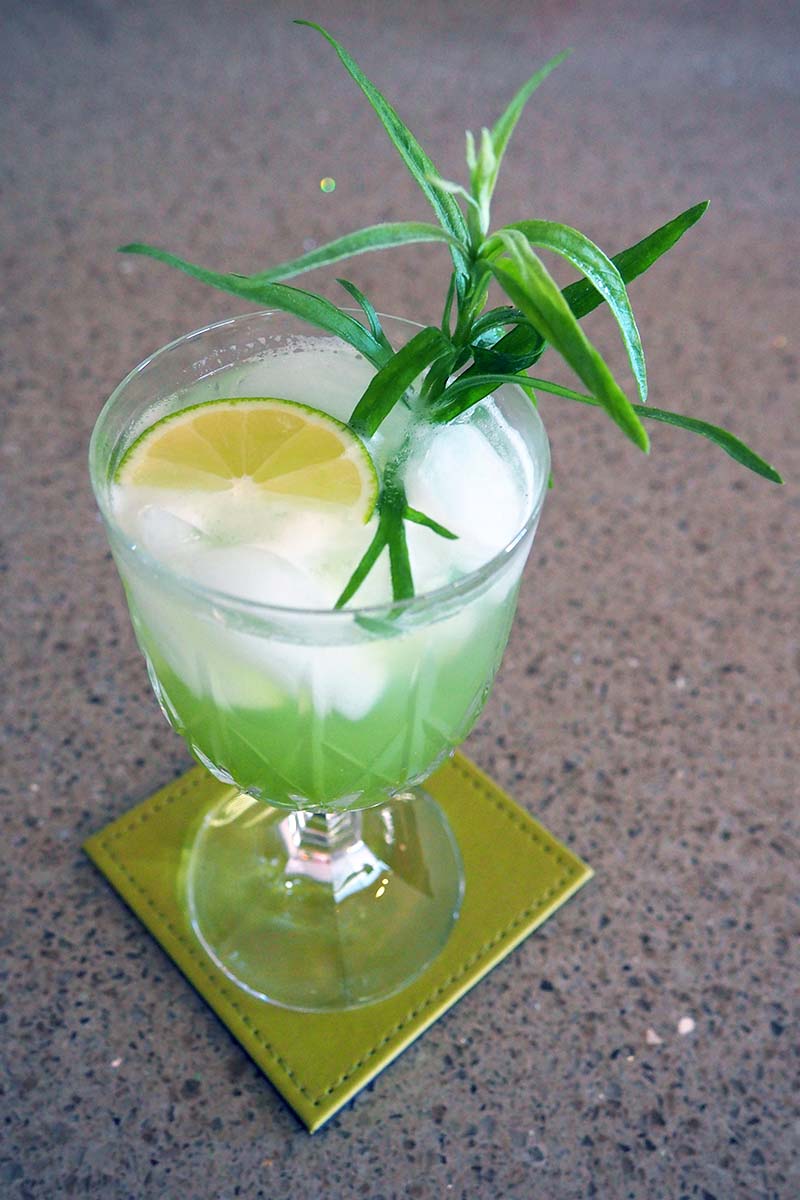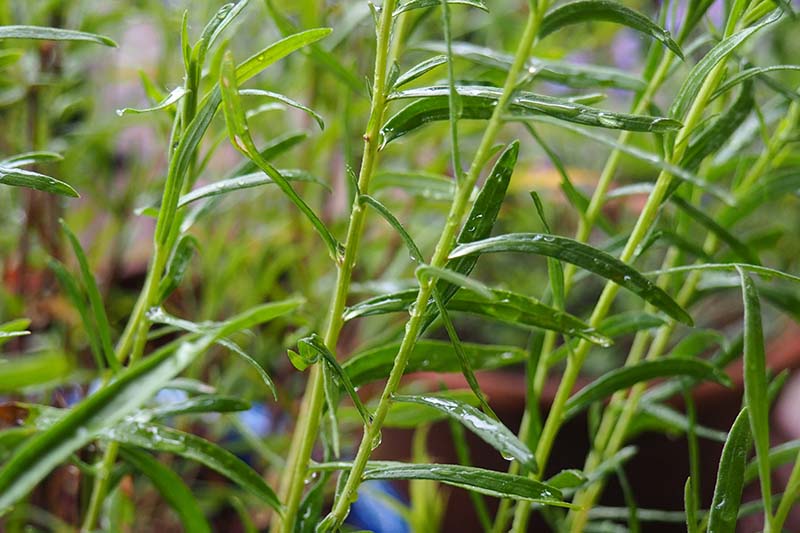It makes a fast-growing and attractive plant in containers or herb borders, and features upright growth, slender green and silver leaves, and a distinct, appealing fragrance. The fresh leaves are used in a variety of dishes, such as those with eggs, fish, mushrooms, tomatoes, and poultry, and are noted for their use in French cuisine and sauces. We link to vendors to help you find relevant products. If you buy from one of our links, we may earn a commission. Although the leaves are at their best fresh, they can also be dried or frozen to enjoy after the growing season ends. And it’s a low maintenance herb too, requiring little care after planting. So if you like your herbs easy, pretty, and tasty, join us now for a look at how to grow French tarragon!
What Is French Tarragon?
French tarragon, A. dracunculus var. sativa, is an herbaceous perennial used extensively in cooking for its sweet licorice flavor. A member of the Asteraceae family, plants are native to the temperate regions of northeastern Europe and central Asia, particularly in the regions bordering the Caspian Sea and the Pamir Mountains, such as Mongolia, Siberia, and Tajikistan. And although its chromosomal profile shows it to be a sterile derivative of the Russian variety, A. dracunculoides pursch, the two shouldn’t be confused. The Russian variety is very similar in shape and appearance to French tarragon. However, its use in the kitchen is limited due to its bitter taste and musty aroma – although people from the Caucasus countries of Armenia, Azerbaijan, and Georgia use it to flavor soft drinks, cider, and tobacco. Known as “false” tarragon, it’s from the same genus and is a very vigorous grower. Unlike its French cousin, the Russian variety is easily grown from seed. Mexican mint tarragon, Tagetes lucida, is an unrelated perennial native to Mexico and Guatemala and also grows from seed, with germination and growth habits similar to that of marigolds. Hardy only to Zone 9, the foliage has a distinct and rich licorice flavor very similar to true tarragon – which makes it well-suited as a culinary substitute in regions with intense summer heat. You can learn more about Mexican tarragon in our guide. In comparison, the French variety has a much fuller flavor than the closely related Russian type, and is considered by chefs and home cooks alike to be of superior quality for culinary purposes. It’s a staple in French cooking and features prominently in herb combinations such as fines herbes, and sauces like Bearnaise. The fresh leaves are used extensively with egg, fish, and poultry dishes, and veggies such as mushrooms and tomatoes. It’s also popular in condiments like mustard and to flavor beverages, as well as in compound butters, herb crusts for fish and poultry, pizza, vegetables, vinaigrettes, vinegar shrubs, vinegars, salad dressings, and sauces. A cool season plant, A. dracunculus var. sativa is one of the first herbs to break dormancy, sending up shoots in late winter or early spring.
Cultivation and History
Also known as “true” tarragon, estragon, dragon herb, or dragon wort, the species name dracunculus is derived from the old Latin word draco and means little dragon – a reference to the twisting, serpentine nature of the roots. Some historians believe that French tarragon found its way to Italy in the 13th century via the Mongol invasion of Europe. It was used in traditional medicines and as a seasoning. According to herbalist folklore, it was later brought to France in the 14th century by Saint Catherine of Siena, and quickly spread throughout Europe where it was grown in monastic gardens. New World settlers brought plants to North America in the 1700s. Plants reach a height of 24 to 36 inches with a 12 to 15-inch spread, and quickly form robust clumps via root runners. The small cream or yellow flowers are insignificant and seeds are sterile, with propagation achieved vegetatively through root division or stem cuttings. An outstanding feature is that frequent pruning produces vigorous branching for a steady supply of leaves throughout spring and summer. Hardy in USDA Hardiness Zones 4-9, plants go into dormancy in fall as the top growth dies back. Tarragon is a “nurse” plant considered to be beneficial throughout the garden, and can be used in herb knots as well as flower and vegetable beds. Pests, such as flea beetles and whiteflies, dislike the fragrance and tend to avoid areas where it’s planted. It’s also thought to improve the flavor and growth of certain crops planted nearby and makes an excellent companion for nightshade crops such as eggplant, tomatoes, and peppers. It’s also well suited to container growth, and makes an attractive and fragrant addition to kitchen gardens and patio pots.
Propagation
French tarragon seed is sterile and propagation must be done vegetatively by root division in spring, or from semi-hardwood stem cuttings in late spring or summer.
Root Division
Root division can be done in late winter or very early spring, once new growth is a few inches tall. Lift plants from the soil with a fork or remove root balls from containers. Using a clean garden knife or spade, carefully cut the root ball into halves, thirds, or quarters, depending on the size of the root mass. A minimum size for divisions are chunks that would fill a four-inch pot. With your fingers, gently remove about one-quarter of the soil from the roots, and trim away any long, dangly root bits that hang below the new root ball. Also remove pieces that are no longer fully attached. Plant the divisions in containers filled with fresh soil or directly in the ground as outlined in the How to Grow section below.
Stem Cuttings
Stem divisions can be taken in late spring or summer, once the stem base has toughened. Using clean, sterile garden scissors, cut stems six to eight inches long, cutting just below a leaf node. Remove the leaves from the lower third of the stem. Dip the cut and stripped end in a rooting compound if desired. Fill small, four to six-inch pots with a light starter soil. Insert the stems about two inches deep and firm the soil gently around them, adding three or four stems per pot. Water lightly. Set the pots in a location where they’ll receive regular water and morning sun or dappled sunlight – but not direct, hot afternoon sun. Roots form in three to four weeks and can be tested with a gentle tug. If there’s resistance, rooting is underway. Plant in containers or in the garden after rooting, spacing cuttings six to 12 inches apart.
How to Grow
Estragon does best in a full sun location with enriched, well-draining soil and a neutral pH of 6.5 to 7.5. Growth is most active in the cool temperatures of spring, and plants will appreciate some afternoon shade in summer’s heat when hot, direct sunshine can cause them to sag. Due to the active root spread of this herb, you may want to give tarragon a dedicated spot of its own. Or you can restrict the roots by sinking plants in the ground in a large pot, or with the use of landscape barriers. Create a planting hole a couple of inches deeper than the root ball and twice as wide. Amend the soil with a shovelful of organic material like mature compost or well-rotted manure. Add some landscape sand or pea gravel to improve drainage if needed. Mix in some bone meal to aid healthy root development. Set the root ball in place, then backfill gently with soil. Ensure the roots are well-covered and protect the crown by adding one to two inches of soil at the base of plants as well. Firm soil in place and water gently to settle. For pots, select a size four to eight inches larger than the root ball. Ensure the pots have drainage holes and add a layer of drainage material, such as broken pottery or pebbles. Set the root ball in place, and cover with amended soil. Firm gently in place and water. Avoid overwatering, which can cause root rot. Allow the top inch or two of soil to dry out before watering. When planted in healthy soil, tarragon typically doesn’t require feeding. However, a high nitrogen fertilizer, such as 4-3-3 (NPK), can be applied once in late spring if needed.
Growing Tips
Keep the following growing tips in mind for a bountiful harvest:
Ensure plants grow in well-draining soil to prevent root rot.Allow the top inch of soil to dry out between watering.Provide afternoon shade in areas with hot temperatures – plants tend to sag in hot sun when temps are above 80°F.
Pruning and Maintenance
Plants can be sheared back to about six inches in late spring, to encourage branching and new growth. Continue to harvest or clip the stems regularly to maintain lush, branching growth throughout the season. Once cool weather sets in, plants will die back and go dormant. After the leaves have yellowed, cut the stems back to three or four inches. In late fall, clean beds and containers of any plant debris to prevent harmful pathogens from overwintering. Before winter, mulch the crown with a two- to four-inch layer of leaf mold or straw to protect against freezing temperatures. Containers can be tucked into a sheltered spot and mulched for winter protection, or brought indoors. In late winter before new growth emerges, remove any mulch, cut back any remaining stems to one inch, and top-dress with organic material such as well-rotted manure or compost. Potted plants will become root bound and benefit from repotting every two to three years, depending on the size of the pot. Downy mildew is caused by oomycetes, microbes that love humid environments and cause plant collapse. And keep in mind that the French variety does not grow from seed – when you find tarragon seeds, they are the Russian type. French Tarragon Burpee offers live plants in a three-pack greenhouse kit that protects plants and retains moisture in shipping.
Managing Pests and Disease
Tarragon has few pest problems, but there are some fungal diseases to watch for. Transferred by wind, leaves develop brown, white, or yellow spots with a fuzzy gray mold on the underside. Remove and destroy infected leaves promptly. Ensure the soil is well-draining and spray with neem oil to prevent infections. A copper-based fungicide can also be used. Powdery mildew is caused by a fungus that attacks leaves, causing them to brown and die. It appears as a white or gray powdery fungus and is spread by wind and water. Remove and destroy infected parts and spray with neem oil. Ensure proper air circulation and water plants in the morning, so that leaves dry by evening. Root rot is caused by fungus in wet soil conditions. Initially, leaves turn yellow and shoot tips wilt, with roots turning brown, black, and rotting, causing plant collapse. Remove and destroy infected plants. Ensure plants have well-draining soil and allow the top inch or two of soil to dry out between watering. Rust is caused by a fungal parasite on the leaves. It appears as small white or yellow spots that form orange or red pustules, causing deformation and defoliation. Spores are transferred by wind or splashing water. Remove and destroy infected leaves, and ensure plant debris is cleared away before winter sets in. Give plants adequate air circulation and avoid splashing water on the leaves.
Harvesting
Leaves can be harvested as soon as the shoots are about six inches tall. Harvest by cutting the stem back to four to six inches, cutting just below a leaf node. Before using, strip the leaves from the stems. In mid-June when plants have reached a mature height, shear back all stems to a height of four to six inches for a new flush of tender growth. Freeze or dry any surplus, as described below. Harvest until mid-fall, or when the lower leaves start to yellow. Read our full guide on harvesting tarragon here.
Preserving
Fresh stems can be kept in the fridge in a small glass of water, or wrapped in a damp paper towel and placed in a plastic bag or storage container in the fridge. For long-term storage, freezing offers better flavor retention than drying, and estragon can be kept in the freezer for up to six months. The leaves darken when frozen but still add plenty of flavor for cooking. Place rinsed and dried stems on a cookie sheet, then freeze. Transfer frozen stems to a resealable plastic bag and remove excess air before sealing and storing in the freezer. You can also strip the leaves by pulling a stem from top to bottom between your thumb and forefinger. Pack leaves in a one-inch layer into a freezer bag and squeeze out the excess air before freezing. Learn more about how to freeze fresh herbs in our guide. To dry, hang bunched stems upside down in a cool, dry, and shady spot until completely dry. When dry, crumble the leaves into a glass jar with a tight fitting lid and store in a cool, dark cupboard. Use within one year. Learn more about drying garden herbs here.
Recipes and Cooking Ideas
For sparkling flavor, pair tarragon with acidic ingredients such as lemon juice or vinegar – a lemon tarragon pesto dressing, like this one from our sister site Foodal, is delicious on a salad prepared with fresh vegetables from the garden. Create your own herbed vinaigrette for salads and vegetables – and be sure to add a pinch of dry mustard for an unforgettable flavor. Add fresh leaves to roasted chicken, fish en papillote, a frittata or omelet, or as a pizza topping. Blend some with cream cheese or soft goat cheese as a tasty spread for bread or crackers. Perk up tomato dishes or a toasted tomato sandwich with a layer of fresh leaves. And for a unique and refreshing drink, add a sprig to a cool summer spritzer or vinegar shrub. You can learn all about making shrubs at home on Foodal as well. Grow some in containers to use for cooking, and plant throughout the garden to ward off unwanted pests. Give them full sun, some water, and just a touch of fertilizer. And divide root-bound plants every two or three years to enjoy a steady supply of sweet flavor and delicate fragrance. How do you folks like to use French tarragon in the garden and kitchen? Let us know in the comments section below! And for more herb growing know-how, be sure to read these articles next:
How to Plant and Grow AniseHow to Grow and Care for FennelHow to Grow Chervil
